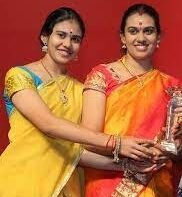By Sukant Deepak New Delhi, April 18 (IANS) While sisters S. Aishwarya and S. Saundarya, two of the most popular Carnatic musicians from the younger generation and great-granddaughters of M.S. Subbulakshmi, recipient of the Bharat Ratna honour feel fortunate to be the musical inheritors of the MS legacy, they say that while drawing inspiration from that, they also maintain their own musical individualities, ensuring there is freedom to operate in their own spaces while still remaining under the framework of the legacy. "My Grandmother Radha Viswanathan was the main reason for this as she assiduously taught me a huge repertoire of the songs which constitute the 'MS Bani' (Gharana). However, we both of us have also learned under different Gurus. While I have been training under Karnataka Kalashree Smt Jambu Kannan, Saundarya has been under the tutelage of Sangita Kala Acharya Smt Neela Ramgopal. This helps us in getting exposed to different dimensions of music, apart from our legacy," says Aishwarya. The duo, who were invited to the Prime Minister House in 2017 during the conclusion of the MS Centenary Celebrations and sang "Maithreem Bhajatha" a Sanskrit composition of Kanchi Paramacharya which their great-grandmother and grandmother had sung at the United Nations in 1966, recall, "Immediately after we completed the song, the PM applauded both of us and said that he was happy at how we were upholding our inherited 'sangeetha parampara'. "The video of both of them singing at the PM's residence had become viral on social media with millions of views. Saundarya, who is also learning Bharatanatyam and plays the western violin feels that Adoing that completes her in many ways. She adds, "My Grandmother Radha Viswanathan was a trained dancer in her younger days, having learnt under legendary Guru Vazhuvoorar. I too learn from Guru Smt Sumitra Nitin, who is an exponent of the Vazhuvoor style. Music and Dance complement each other. As a singer, I am able to better relate to the emotion conveyed by the composer and that comes in because of my training in Bharatanatyam. "Western Violin has helped a lot when I play Carnatic Violin. However, apart from that, learning Western Music has given me exposure to a totally different genre of music. I have also completed Grade 5 in Western Violin conducted by BRSM (Associated Board of the Royal School of Music London)." Talk to them about the immense popularity they enjoy on social media, and Aishwarya feels that social media platforms are very important in projection of art forms. "There is so much music available on YouTube. If used well, social media platforms can become important facilitators in the journey of an artist. Its reach is indeed global and distances become redundant. In Carnatic Music for example, which has seen fewer footfalls in live concerts, web- casting the same concert also means that more viewers can enjoy the music. During last year, which was a terrible year for arts and artists due to the Covid-19 pandemic, social media came to the rescue as an alternative and many online concerts were web-cast to appreciative audiences." Even as platforms for classical music keep declining, Aishwarya opines that art requires support from both the government as well as the corporate sector. "Governments can provide scholarships to music students. Also, if a student has a diploma in fine arts apart from his other professional qualifications, there can be some weightage given to him/her for admissions to higher courses or for employment. Corporates can invite classical musicians to perform for their annual programs. Musicians must have faith that pursuing a career in classical arts is a safe bet for their future." The duo, who were part of the recently organised 'HCL Baithak' feels that the corporate has for so many decades been supporting Indian classical music in a very systematic way. "Musicians practice so rigorously to perfect the art form. Providing them with concert opportunities that will help their music reach a wider audience will be of great support. That is something that corporates can surely do." Considering the fact that last year didn't translate into concerts, the sisters experimented with Western harmonics during the rendition of Swaras for the popular song Vathapi Ganapathim in raga Hamsadhwani. "This was done with just our voices by singing different notes at the same time to create a chord like effect. Of course, there are many other ways collaborations can be done in the future with Western musicians as well," says Saundarya. Stressing that making art forms compulsory upto the fifth grade, combined with art appreciation courses, quiz competition, classical music competitions etc. will surely pave way for the creation of a pool of music lovers who will support classical arts in the future, Aishwarya says, "Making Classical Arts a lovely learning experience for students will require good music & dance teachers who must be supported." (Sukant Deepak can be contacted at sukant.d@ians.in)












